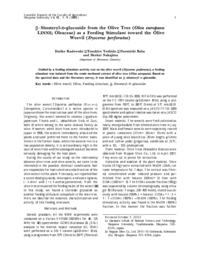

Scientific Reports of the Faculty of Agriculture, Okayama University
Published by the Faculty of Agriculture, Okayama UniversityONLINE ISSN : 2186-7755
Permalink : https://ousar.lib.okayama-u.ac.jp/10582
β-SitosteryI-D-glucoside from the Olive Tree(Olea europaea LINNE; Oleaceae) as a Feeding Stimulant toward the Olive Weevil (Dyscerus perforatus)
門脇 英美子
岡山大学
Yoshida, Yasuhiro
Nippon Olive Co., Ltd.
馬場 直道
岡山大学
発行日
2003-02
抄録
The olive weevil [Dyscerus perforatus (ROELOFS); Coleopetera; Curculionidae] is a native species in Japan and now the most serious pest of the olive trees. Originally, this weevil seemed to colonise Ligustrum japonicum Thumb. and L. obtusifolium Sieb. et Zucc, both of which belong to the same oleacea family as olive. However, when olive trees were introduced to Japan in 1908, the weevils immediately attacked the plants and soon preferred them to the former hosts. Unlike in the former hosts, where the weevils live in a low population density, it is extraordinary high in the case of olive trees and the subsequent assault becomes seriously damaging for the host plant. During the course of our study on the relationship between olive trees and olive weevils, we came to be interested in the possible chemical constituents that are responsible for host selection and attraction of the olive weevil to this plant. Previously, we reported that a secoiridoid gluconside, oleuropein, and some lignans, (-)-olivil and (+)-l-acetoxypinoresinol, from the olive tree stimulated the feeding habit of the weevil. In this study, we found a steroidal glucoside as another feeding stimulant component in the olive tree. Here, we describe the isolation, characterization and activity of this feeding stimulant.
キーワード
Computer simulation
Selection
Crossbreeding
Population structure
ISSN
0474-0254
NCID
AN00033029
